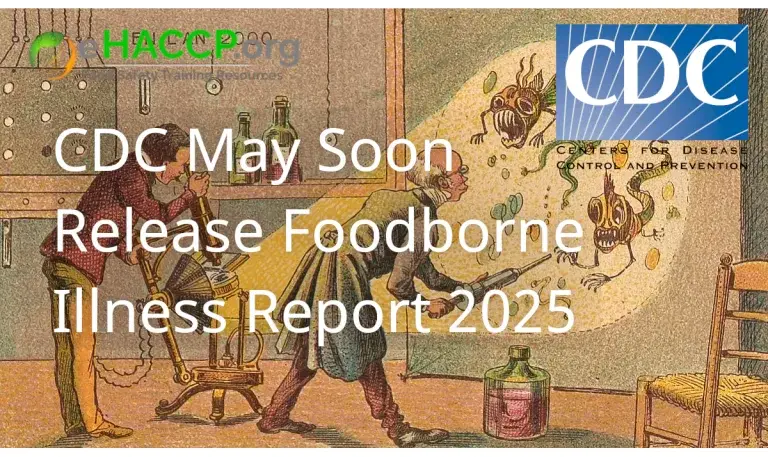The CDC will publish its first comprehensive report since 2011, “Foodborne Illness Acquired in the United States—Major Pathogens.” Although there have been updates, a comprehensive report may soon be published. The last comprehensive update on the CDC’s statistics of foodborne illnesses and deaths was published in 2023. This report included preliminary estimates of pathogen-specific annual incidences during 2022, compared with average yearly incidences from 2016 to 2018.
CDC plans to publish updated estimates of the number of U.S. domestically acquired foodborne illnesses, hospitalizations, and deaths 2019 caused by seven significant pathogens. The pathogens are Campylobacter spp., Clostridium perfringens, invasive Listeria monocytogenes, norovirus, Salmonella (nontyphoidal), Shiga toxin-producing Escherichia coli (STEC), and Toxoplasma gondii.
Highlights
- 9.9 million: The number of domestically acquired foodborne illnesses that six pathogens caused CDC estimates: Campylobacter spp., C. perfringens, invasive Listeria, norovirus, Salmonella, and STEC.
- 53,300: The number of hospitalizations the CDC estimates resulted from domestically acquired foodborne illnesses caused by all seven pathogens.
- 931: The CDC estimates the number of deaths resulting from domestically acquired foodborne illnesses caused by all seven pathogens.
- Norovirus, Campylobacter spp., and Salmonella: The CDC estimates that these pathogens caused the most domestically acquired foodborne illnesses.
- Salmonella, Campylobacter spp., norovirus, and invasive Listeria are the pathogens that the CDC estimates caused the most fatal domestically acquired foodborne illnesses.
What were the results of the 2011 report
Foodborne Illnesses
We estimate that each year in the United States, 31 pathogens caused 37.2 million (90% CrI 28.4–47.6 million) illnesses, of which 36.4 million (90% CrI 27.7–46.7 million) were domestically acquired; of these, 9.4 million (90% CrI 6.6–12.7 million) were foodborne (Table 2). We estimate that 5.5 million (59%) foodborne illnesses were caused by viruses, 3.6 million (39%) by bacteria, and 0.2 million (2%) by parasites. The pathogens that caused the most illnesses were norovirus (5.5 million, 58%), nontyphoidal Salmonella spp. (1.0 million, 11%), C. perfringens (1.0 million, 10%), and Campylobacter spp. (0.8 million, 9%).
Hospitalizations
We estimate that these 31 pathogens caused 228,744 (90% CrI 188,326–275,601) hospitalizations annually, of which 55,961 (90% CrI 39,534–75,741) were caused by contaminated food eaten in the United States (Table 3). Of these, 64% were caused by bacteria, 27% by viruses, and 9% by parasites. The leading causes of hospitalization were nontyphoidal Salmonella spp. (35%), norovirus (26%), Campylobacter spp. (15%), and T. gondii (8%).
Deaths
We estimate that these 31 pathogens caused 2,612 deaths (90% CrI 1,723–3,819), of which 1,351 (90% CrI 712–2,268) were caused by contaminated food eaten in the United States (Table 3). Of these, 64% were caused by bacteria, 25% by parasites, and 12% by viruses. The leading causes of death were nontyphoidal Salmonella spp. (28%), T. gondii (24%), L. monocytogenes (19%), and norovirus (11%).
When will the report be released?
The CDC has not announced a specific release date for its 2025 report on foodborne illness hospitalizations and deaths. However, based on historical patterns, the CDC typically releases such updates annually, often in the first half of the year. Given this, you might expect the release sometime in the first few months of 2025, potentially around late winter or early spring. For the most accurate and up-to-date information, it would be best to check the CDC’s official website or follow their announcements on their social media or press releases.
We have heard that the report may be published by the end of 2025. However, this is only speculation based on off-the-record conversations with individuals working with and for the CDC.
Who reads this report?
As a HACCP and food safety training company, eHACCP.org relies on the most current, reliable, and date information to keep its HACCP training and HACCP certification courses current to prove its students with the best information.
Federal, state, and local health departments use the data to monitor trends, respond to outbreaks, and plan public health interventions.
Agencies such as the U.S. Food and Drug Administration (FDA), the U.S. Department of Agriculture’s Food Safety and Inspection Service (USDA-FSIS), and state agricultural departments use this information to set policies, regulations, and standards for food safety.
Researchers and Epidemiologists analyze the data for academic research to develop new detection and prevention methods and understand foodborne disease epidemiology.
Food Industry professionals like food manufacturers, processors, and retailers use the data to improve their safety protocols, identify high-risk areas in their supply chain, and respond to outbreaks.
Physicians, nurses, and other healthcare workers might use these reports to stay informed about common pathogens, symptoms, treatment options, and prevention strategies for their patients.
Organizations focused on consumer rights and food safety use these reports to advocate for better regulations, educate the public, and sometimes challenge industry practices.
Educators and Academics in educational settings use it to teach public health, microbiology, epidemiology, and food science.
Media and journalists report on the statistics, trends, and specific outbreaks to inform the public and raise awareness about food safety issues.
While the raw data might be complex for the average person to interpret, summaries, news articles, or public health advisories based on these reports reach the public and influence consumer behavior and awareness.
Policymakers and legislators may use the data to inform legislation, funding decisions, and public health policy related to food safety.
This wide readership underscores the importance of these reports in shaping policy and practice in food safety and public health. However, specific interest in detailed reports might vary, with some groups focusing more on executive summaries or particular sections relevant to their work.
We are excited and curious to see what the report has to offer. We hope that with better reporting and education, there will be a marked improvement in the results, and people will experience fewer foodborne illnesses, hospitalizations, and deaths.

